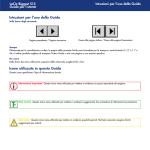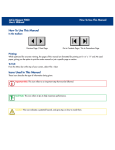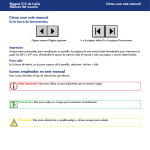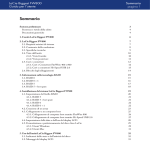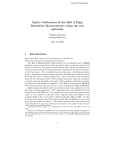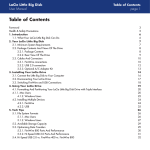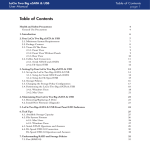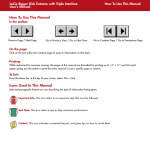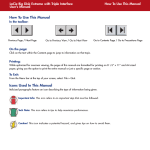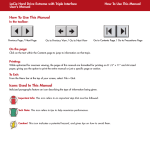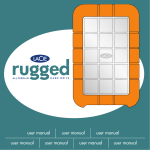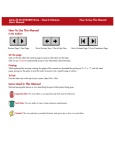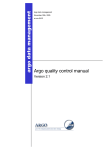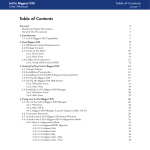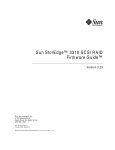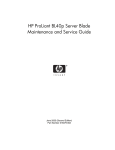Download Biggest Quadra User Manual
Transcript
LaCie Biggest Quadra User Manual Table of Contents page Table of Contents Health and Safety Precautions General Use Precautions 1. Introduction to the LaCie Biggest Quadra 4 4 6 2. About the LaCie Biggest Quadra 2.1. Minimum System Requirements 2.2. Package Content 2.3. Specifications 2.4. Views of the Drive 2.4.1. Front View 2.4.2. Rear View 2.5. Cables and Connectors 2.5.1. FireWire 400 and 800 Cables and Connectors 2.5.2. Hi-Speed USB 2.0 Cables and Connectors 2.5.3. eSATA Cables and Connectors 2.6. Drive Tray Locks 7 7 8 9 10 10 11 12 12 13 14 15 3. Understanding RAID 3.1. RAID 0 3.2. RAID 0 + 1 3.3. RAID 5 3.4. RAID 5 + Hot Spare 16 16 17 18 19 4. Setting Up Your LaCie Biggest Quadra 4.1. Setting the RAID Level 4.1.1. RAID 5 4.1.2. RAID 5 + Hot Spare 4.1.3. RAID 0 4.1.4. RAID 0 + 1 4.2. Creating an Array 4.2.1. Initializing the Disks 4.2.2. Managing Volumes over 2TB in Windows 4.3. Connecting to a Host Computer 4.3.1. Connecting to the Host Computer via FireWire 4.3.2. Connecting to the Host Computer via Hi-Speed USB 2.0 4.3.3. Connecting to the Host Computer via eSATA 4.4. Setting the LCD Display Time & Date 4.5. Formatting and Partitioning 4.5.1. Windows Users 4.5.2. Mac Users 20 21 22 22 23 23 24 24 26 27 28 29 30 31 32 32 34 LaCie Biggest Quadra User Manual Table of Contents page 5. Using the LaCie Biggest Quadra 5.1. Disk Status and Activity Indicators 5.2. LCD Display Messages 5.2.1. Initialization Messages 5.2.2. Rebuild Messages 5.2.3. Failure and Error Messages 5.2.4. RAID and Disk Status Messages 5.2.5. RAID and Disk Information Messages 35 35 36 36 37 38 39 40 6. Maintaining Your LaCie Biggest Quadra 6.1. Removing/Replacing A Drive 6.2. Firmware Updates 42 42 42 7. Technical Information 7.1. File System Formats 7.2. Available Storage Capacity 7.3. Optimizing Data Transfers 43 43 45 45 8. FireWire Questions & Answers 48 9. USB Questions & Answers 50 10. eSATA Questions & Answers 52 11. Troubleshooting 54 12. Contacting Customer Support 12.1. LaCie Technical Support Contacts 56 57 13. Warranty Information 58 LaCie Biggest Quadra User Manual Copyrights Copyright © 2007 LaCie. All rights reserved. No part of this publication may be reproduced, stored in a retrieval system, or transmitted in any form or by any means, electronic, mechanical, photocopying, recording or otherwise, without the prior written consent of LaCie. Trademarks Apple, Mac, Macintosh and FireWire are registered trademarks of Apple Computer, Inc. Microsoft, Windows NT, Windows 98, Windows 98 SE, Windows 2000, Windows Millennium Edition, Windows Server 2003, Windows XP and Windows Vista are registered trademarks of Microsoft Corporation. Sony and iLink are registered trademarks of Sony Electronics. Other trademarks mentioned in this manual are the property of their respective owners. Changes The material in this document is for information only and subject to change without notice. While reasonable efforts have been made in the preparation of this document to assure its accuracy, LaCie assumes no liability resulting from errors or omissions in this document, or from the use of the information contained herein. LaCie reserves the right to make changes or revisions in the product design or the product manual without reservation and without obligation to notify any person of such revisions and changes. Forward page LaCie Biggest Quadra Tested To Comply With FCC standards FOR HOME OR OFFICE USE FCC Statement This device complies with Part 15 of the FCC Rules. Operation is subject to the following conditions: 1. The devices may not cause harmful interference 2. The devices must accept any interference received, including interference that may cause undesired operation NOTE: This equipment has been tested and found to comply with the limits for a Class B digital device, pursuant to Part 15 of the FCC Rules. These limits are designed to provide reasonable protection against harmful interference in a residential installation. This equipment generates, uses and can radiate radio frequency energy and, if not installed and used in accordance with the instructions, may cause harmful interference to radio communications. However, there is no guarantee that interference will not occur in a particular installation. If this equipment does cause harmful interference to radio or television reception, which can be determined by turning the equipment off and on, the user is encouraged to try and correct the interference by one or more of the following measures: ❖ Reorient or relocate the receiving antenna. ❖ Increase the separation between the equipment and receiver. ❖ Connect the equipment into an outlet on a circuit different from that to which the receiver is connected. ❖ Consult the dealer or an experienced radio/TV technician for help. Modifications to this product not authorized by LaCie could void the FCC & Industry Canada regulations and negate your authority to operate the product. Canada Compliance Statement This Class B digital apparatus complies with Canadian ICES-003. Manufacturer’s Declaration for CE Certification We, LaCie, solemnly declare that this product conforms to the following European standards: Class B EN60950-1:2003, EN55022: 1998, EN55024:1998 +A1, EN610003-2: 2000, EN61000-3-3:2001 With reference to the following conditions: 73/23/EEC Low Voltage Directive 89/336/EEC EMC Directive LaCie Biggest Quadra User Manual This symbol on the product or on its packaging indicates that this product must not be disposed of with your other household waste. Instead, it is your responsibility to dispose of your waste equipment by handing it over to a collection point for the recycling of electrical and electronic equip- Forward page ment. The collection and recycling of your waste equipment at the time of disposal will help to conserve resources and ensure that it is recycled in a way that protects health and the environment. For information about where you can drop off your equipment for recycling, please contact your city waste disposal service. CAUTION: A shielded-type power cord is required in order to meet FCC emission limits and also to prevent interference to the nearby radio and television reception. It is essential that only the supplied power cord be used. Health and Safety Precautions Only qualified persons are authorized to carry out maintenance on this device. • Read this User’s Guide carefully, and follow the correct procedure when setting up the device. • Do not open your LaCie Biggest Quadra or attempt to disassemble or modify it. Never insert any metallic object into the drive to avoid any risk of electrical shock, fire, short-circuiting or dangerous emissions. Your LaCie Big- gest Quadra contains no user-serviceable parts. If it appears to be malfunctioning, have it inspected by a qualified LaCie Technical Support representative. • Never expose your device to rain, or use it near water, or in damp or wet conditions. Never place objects containing liquids on the LaCie Biggest Quadra, as they may spill into its openings. Doing so increases the risk of electrical shock, short-circuiting, fire or personal injury. • Make sure that the computer and LaCie Biggest Quadra are electrically grounded. If the devices are not grounded, there is an increased risk of electrical shock.Power requirements 100-240 V~, 4-2 A, 60-50 Hz, (Supply voltage fluctuations not exceeding ± 10% of the nominal, transient over-voltages according to over-voltage category II). General Use Precautions ❖ Do not expose the LaCie Biggest Quadra to temperatures outside the range of 0° C to 35° C (32° F to 95° F); or to operational humidity beyond 5-95%, non-condensing, or non-operating humidity beyond 5-95%, non-condensing. Doing so may damage the LaCie Biggest Quadra or disfigure its casing. Avoid placing your LaCie Biggest Quadra near a source of heat or exposing it to sunlight (even through a window). Inversely, placing your LaCie Biggest Quadra in an environment that is too cold or humid may damage the unit. ❖ Rated cooling for altitudes up to 2000 meters. ❖ Always unplug the LaCie Biggest Quadra from the electrical outlet if there is a risk of lightning or if it will be unused for an extended period of time. Otherwise, there is an increased risk of electrical shock, short-circuiting or fire. ❖ Use only the power supply shipped with the device. ❖ Do not use the LaCie Biggest Quadra near other electrical appliances such as televisions, radios or speakers. Doing so may cause interference which will adversely affect the operation of the other products. ❖ Do not place the LaCie Biggest Quadra near sources of magnetic interference, such as computer displays, televisions or speakers. Magnetic interference can affect the operation and stability of your LaCie Biggest Quadra. LaCie Biggest Quadra User Manual Forward page ❖ Do not place heavy objects on top of the LaCie Biggest Quadra or use excessive force on it. ing use or storage. Dust can build up inside the device, increasing the risk of damage or malfunction. ❖ Never use excessive force on your LaCie Biggest Quadra. If you detect a problem, consult the Troubleshooting section in this manual. ❖ Never use benzene, paint thinners, detergent or other chemical products to clean the outside of the LaCie Biggest Quadra. Such products will disfigure and discolor the casing. Instead, use a soft, dry cloth to wipe the device. ❖ Protect your LaCie Biggest Quadra from excessive exposure to dust dur- ❖ Do not attempt to remove a hard disk from a drive tray. Removal of a hard disk by anyone other than an authorized LaCie Technical Support representative will void the warranty. CAUTION: Modifications not authorized by the manufacturer may void the user’s authority to operate this device. Important Info: Any loss, corruption or destruction of data while using a LaCie drive is the sole responsibility of the user, and under no circumstances will LaCie be held liable for the recovery or restoration of this data. To help prevent the loss of your data, LaCie highly recommends that you keep TWO copies of your data; one copy on your external hard drive, for instance, and a second copy either on your internal hard drive, another external hard drive or some other form of removable storage media, such as CD, DVD or Tape. LaCie offers a complete line of CD, DVD and Tape drives, and if you would like more information on backup, please refer to the LaCie white paper on backup methods and technology. Important Info: 1GB = 1,000,000,000 bytes. 1TB = 1,000,000,000,000 bytes. Once formatted, the actual available storage capacity varies depending on operating environment (typically 5-10% less). LaCie Biggest Quadra User Manual 1. Introduction to the LaCie Biggest Quadra Congratulations on the purchase of your new LaCie Biggest Quadra. This high-performance, extremely flexible RAID (Redundant Array of Independent/Inexpensive Disks) subsystem is ideally suited for integration with databases, imaging systems and e-mail and Web servers. RAID technology is one of the best means to protect your data, while providing greater performance, data integrity and availability than standard hard disk storage. With single error detection and disk parity used to recover data if a disk fails, a RAID system ideal for safeguarding valuable data while streamlining performance. The LaCie Biggest Quadra is the ultimate approach to a flexible RAID solution, managing three different RAID levels (0, 0+1 and 5) and offering the option of RAID 5 + hot spare. Featuring intelligent online recovery, the LaCie Biggest Quadra allows one drive to be designated a hot spare – if one drive fails, the LaCie Biggest Quadra will seamlessly rebuild the failed drive’s data on the hot spare. ■ Biggest Quadra Features ❖ Supports powerful RAID 0, 0+1, 5, and RAID 5+spare ❖ Hot swappable SATA disk drives for security and recovery ❖ eSATA 1.5 Gbits/s interface ❖ Automatic on-line rebuilding (RAID 0+1, 5, 5+) ❖ Event notification through audible alarm ❖ LCD panel for operational status display Introduction page LaCie Biggest Quadra User Manual About the LaCie Biggest Quadra page 2. About the LaCie Biggest Quadra 2.1. Minimum System Requirements Windows Users ❖ Pentium III or higher compatible processor ❖ 128MB RAM or greater ❖ Windows 2000, Windows Server 2003, Windows XP or Windows Vista ❖ Available eSATA*, USB 2.0, FireWire 400 or FireWire 800* interface port Mac Users ❖ ❖ ❖ ❖ G3 and later or Intel Core processor 128MB RAM or greater Mac OS 10.2.8 or later Available eSATA*, USB 2.0, FireWire 400 or FireWire 800* interface port * Most computers do not come from the factory with FireWire 800 or eSATA ports, so you may need to purchase a PCI, PCI-X or PCI-Express card to be able to connect your Biggest Quadra via these interfaces. LaCie offers a wide selection of eSATA and FireWire 800 cards. Visit the LaCie website at www.lacie.com/accessories Technical note: Windows 2000 Users! In order for the LaCie Biggest Quadra to be recognized by your computer using the FireWire/IEEE 1394 interface, you must have Windows Service Pack 3 installed on your operating system. To ensure that you have the correct configuration, right click on My Computer and select Properties. The System Properties dialog box will appear. Click on the General tab and this will list which version of the Windows operating system you are currently running. Technical note: Mac Users! USB Connectivity: For optimal performance under the Mac OS, it is recommended that you use the FireWire interface unless you are using a G5 or are running Mac OS 10.2.8 or later on a computer with a Hi-Speed USB 2.0 PC or PCI card. All versions of the Mac OS before Mac OS 10.2.8 do not support the transfer rates of Hi-Speed USB 2.0, and all data transfers will be made at the slower USB 1.1 rates. LaCie Biggest Quadra User Manual About the LaCie Biggest Quadra page 2.2. Package Content Your LaCie hard drive package should contain the following: 1 SATA SATA 2 4 3 6 5 9 Biggest FW800 Biggest FW800 User Manual & Utilities version 1.0 ©2 006 L aCie , all rights reser ved. 7109 060 24 LaCie Biggest Quadra RAID with 4 SATA hard disks 2 eSATA cable 3 FireWire 800 9-to-9-pin cable 4 FireWire 800/400 9-to-6-pin cable 5 Hi-Speed USB 2.0 cable 6 Power cable 7 Drive lock keys (2) 8 LaCie Utilities CD-ROM 9 Quick Install Guide Important Info: Please save your packaging. In the event that the drive should need to be repaired or serviced, it must be returned in its original packaging. In the event that an individual disk should need to be repaired or serviced, please refer to section 6.1. Removing or Replacing a Drive. 7 8 1 5 90 Quick Install Guide LaCie Biggest Quadra User Manual 2.3. Specifications ■ Host Interface ❖ eSATA, FireWire 400, FireWire 800 and USB 2.0 ■ Weight and Dimensions ❖ 25.3 lbs/11.5 Kgw ❖ 152.8 x 206.4 x 268.5 mm ■ Operation Temperature ❖ 0 - 35°C ■ Operation Humidity ❖ 5 - 95%, non condensing ■ Storage Humidity ❖ 5 - 95%, non-condensing ■ Power Supply ❖ 200W; input 100~250V AC; output +5V/10A, +12V/10A, +3.3V/5A ■ Available Capacity ❖ RAID 0 = 100% ❖ RAID 0+1= 50% ❖ RAID 5 = 75% ❖ RAID 5+ Spare = 50% About the LaCie Biggest Quadra page LaCie Biggest Quadra User Manual About the LaCie Biggest Quadra page 10 2.4. Views of the Drive ■ 2.4.1. Front View 5 4 3 1 Disk Activity Indicator – Indicates when the disk is being accessed. For more information, please see section 5.1. Disk Status and Activity Indicators. 2 Disk Status Indicator – Indicates the status of the disk. For more information, please see section 5.1. Disk Status And Activity Indicators. 3 Enter/Mute Button – The enter button is used to set the date and time, and is also used to mute the alert buzzer. 4 LCD Display – The LCD Display alerts you to the status and configuration information of your LaCie Biggest Quadra’s subsystem and arrays. For more information about the LCD Display messages, please see section 5.2. LCD Display Messages. 5 Scroll Button – The scroll button is used to navigate through the information on the LCD Display, and is used to select settings for setting the date and time. 6 Drive Trays – Each drive tray can hold one-inch high, 3.5-inch SATA disk drive. 2 Disk 1 Disk 6 Disk Disk 7 Fig. 2.4.1. CAUTION: To avoid overheating, the LaCie Biggest Quadra should be installed in a well-ventilated area and in such a way as to maintain sufficient airflow across the controller chips. Also ensure that the Ventilation Fan is not obstructed. Environmental Requirements: Temperature: 0 – 35° C (32 – 95° F) Operation Humidity: 5 – 95%, non-condensing Storage Humidity: 5 – 95%, non-condensing Disk 1 – This is also the default Hot Spare Disk. Disks 2 – 4 7 Drive Locks – Protect your Biggest Quadra’s drives from accidental removal and damage by locking the drives into their bays. See section 2.6. Drive Tray Locks. LaCie Biggest Quadra User Manual About the LaCie Biggest Quadra page 11 ■ 2.4.2. Rear View 1 Ventilation Fan – The ventilation fan keeps your drive cool during operation. Be sure not to block the fan when using your drive. 2 Power Switch – The power svwitch is the main on/off switch for the LaCie Biggest Quadra. 3 Power Supply Connector – This is where you plug in the AC adapter supplied with the drive. For more information, please see section 4.2. Creating An Array. 4 Power Supply Fan – The power supply fan provides ventilation for the internal power supply to prevent overheating. 5 eSATA Port – This is where you plug in the eSATA cable furnished with the drive. For more information, please see sections 2.5. Cables & Connectors, 4.3. Connecting to a Host Computer, and 11. eSATA Questions & Answers. 6 Hi-Speed USB 2.0 Port – This is where you plug in the Hi-Speed USB 2.0 cable furnished with the drive. For more information, please see sections 2.5. Cables & Connectors, 4.3. Connecting to a Host Computer, and 9. USB Questions & Answers. 7 FireWire 800 Ports – This is where you plug in the FireWire 800 cable furnished with the drive. For more information, please see section 2.5. Cables & Connectors, 4.3. Connecting to a Host Computer and 8. FireWire Questions & Answers. 8 Serial/RS-232 Port – The Serial/RS-232 Port is used to connect the LaCie Biggest Quadra to a terminal or a terminal equipped PC with terminal emulation software. The status of the LaCie Biggest Quadra can then be viewed remotely. For more information on firmware updates please contact LaCie Technical Support. 6 7 5 eSATA USB 8 9 0 5 0-1 5-S 1 4 3 2 Fig. 2.4.2. 9 RAID Level Switch Selectors – The RAID Level Switch Selectors consist of two switches, which are used to set the RAID level. For more information, please see section 4.1. Setting the RAID Level. LaCie Biggest Quadra User Manual About the LaCie Biggest Quadra page 12 2.5. Cables and Connectors ■ 2.5.1. FireWire 400 and 800 Cables and Connectors FireWire 400, also known as IEEE 1394, is a highspeed serial input/output technology for connecting peripheral devices to a computer or to each other, and FireWire 800 is the implementation of the new IEEE 1394b standard. FireWire 800 offers increased bandwidth and extended distance between devices. FireWire 800 is ideal for bandwidth-intensive applications, such as audio, video and graphics. Please see section 8. FireWire Questions & Answers for more information on FireWire. FireWire 800 Benefits ❖ Resourceful architecture: FireWire 800 reduces delays in arbitration and signal distortion, and increases throughput. ❖ Backwards compatibility: adapter cables allow FireWire 400 devices to operate under the FireWire 800 port (at FireWire 400 speed). FireWire 400 & FireWire 800 Benefits FireWire Icons Theses icons will help you easily identify the FireWire interface. They appear on FireWire cables, and next to the FireWire port connectors on certain computers. ❖ Hot-pluggable: devices can be added and removed while the bus is active. ❖ Isochronous data delivery: no dropped frames – FireWire supports real-time data delivery. ❖ Flexible: up to 63 devices can be connected on a single bus. FireWire icon iLink icon DV icon FireWire Cables There are two categories of FireWire cables on the market: FireWire 800 cables, which feature the 9-to-9pin, 9-to-6-pin, and 9-to-4-pin cables; and the original FireWire cables which feature the 6-to-6-pin and 6-to4-pin cables. FireWire 800 9-to-9 Pin Cable and Cable End FireWire 800 9-to-6 Pin Cable and Cable End iLink/DV Cable and Cable End (Sold Separately) LaCie Biggest Quadra User Manual About the LaCie Biggest Quadra page 13 ■ 2.5.2. Hi-Speed USB 2.0 Cables and Connectors USB is a serial input/output technology for connecting peripheral devices to a computer or to each other. Hi-Speed USB 2.0 is the latest implementation of this standard, and it provides the necessary bandwidth and data transfer rates to support high speed devices such as hard drives, CD/DVD drives and digital cameras. Please see section 9. USB Questions & Answers for more information on USB’s uses and capabilities. USB Icons These icons will help you easily identify the USB interfaces. They appear on USB cables and next to the USB port connectors on certain computers. USB 2.0 icon USB 1.1 icon USB 2.0 Cables Your LaCie drive is shipped with a Hi-Speed USB 2.0 cable, to ensure maximum data transfer performance when connected to a Hi-Speed USB 2.0 port. The cable will also work when connected to a USB port, but drive performance will be limited to USB 1.1 transfer rates. USB 2.0 Cable Ends Hi-Speed USB 2.0 Benefits ❖ Backwards compatibility: Hi-Speed USB 2.0 works with the original USB specifications. ❖ Hot-swappable: no need to shut down or restart your computer when adding or removing devices. LaCie Biggest Quadra User Manual About the LaCie Biggest Quadra page 14 ■ 2.5.3. eSATA Cables and Connectors Your LaCie Biggest Quadra uses the latest in SATA technology, allowing interface (or bus) transfer rates of up to 3 Gbits/s. SATA technology was originally developed to serve as an internal interface, delivering improved performance to internal connections. Soon after, eSATA, or external SATA was developed, allowing for the use of shielded cables outside the PC. eSATA technology was developed to be rugged and durable. eSATA connectors do not have the “L” shaped design of other SATA connectors. In addition, the guide features are vertically offset and reduced in size to prevent the use of unshielded internal cables in external applications. eSATA Icons This icon will help you easily identify the eSATA interfaces. They appear on eSATA cables and next to the eSATA port connectors on certain computers. eSATA 1.5 Gbits/s icon eSATA Cables S-ATA S-ATA Your LaCie drive is shipped with a eSATA cable, to ensure maximum data transfer performance when connected to a eSATA port. eSATA Cable and Cable End LaCie Biggest Quadra User Manual About the LaCie Biggest Quadra page 15 2.6. Drive Tray Locks The Biggest Quadra’s drive trays can be locked into place with the provided keys to prevent accidental drive tray removal and damage. LaCie recommends that you keep your drive trays locked while the Biggest Quadra is in use. To lock a drive tray: 1. Ensure that the drive tray is fully seated in its bay. 2. Insert the key into the lock. 3. Turn the key to the right until the arrow on the lock aligns with the “locked” symbol (A). See Fig. 2.6. CAUTION: To prevent the unexpected or accidental pull-out of drive trays, LaCie recommends that you keep drive trays locked while the Biggest Quadra is in use. Always unlock drive trays before attempting to remove them from or install them in the system tower. Failure to do so may damage the drives and void the warranty. To unlock a drive tray: 1. Insert the key into the lock. 2. Turn the key to the let until the arrow on the lock aligns with the “unlocked” symbol (B). See Fig. 2.6. Important Info: The drive tray keys are exactly the same size as 5mm hex key wrenches. If you can not find the keys provided with your Biggest Quadra, you can also use 5mm hex key wrenches to unlock the drive trays. Fig. 2.6. LaCie Biggest Quadra User Manual Understanding RAID page 16 3. Understanding RAID Your LaCie Biggest Quadra is shipped with a preconfigured RAID level of 5, but it supports four different RAID levels: 0, 0 + 1, 5 and 5 + Hot Spare. This section will help you decide which RAID level is right for you. 3.1. RAID 0 Striped Disk Array Without Fault Tolerance Also called striping, this level offers high transfer rates and is ideal for large blocks of data where speed is of the utmost importance. RAID 0 implements a striped disk array, where all of the hard disks are linked together to form one large aggregate hard disk. In this configuration, data is broken down into blocks and each block is written to a separate disk drive within the array; I/O performance is greatly improved by spreading the I/ O load across several drives. In this array, however, when one disk fails, all of the data on the array is lost. ■ Characteristics and Advantages ❖ Data is broken down into blocks and each block is written to a separate disk drive ❖ I/O performance improved by spreading the load across multiple drives ❖ Overhead is lowered due to no calculations for parity ❖ Simple design and easily implemented Storage capacity is determined by the smallest disk in the array, and the smallest disk’s capacity is applied to all of the other disks in the array. So, for instance, if you had four disks installed, ranging in capacity from 40GB to 80GB, when the RAID 0 array is built your system will see one, 160GB (40GB x 4) hard disk. While this is a very simple and easily implemented design, RAID 0 should never be used in mission critical environments. When even just one disk in the array fails, all of the data on the entire array will be lost. ■ Recommended Uses ❖ Video production and editing ❖ Image editing ❖ Pre-press applications ❖ Applications requiring high-bandwidth This diagram represents a RAID 0 array, consisting of four disks, which are connected to the Controller. Data blocks are distributed across all of the disks in the array. E D C B A CONTROLLER A E I M B F J N C G K O D H L Etc... Fig. 3.1. LaCie Biggest Quadra User Manual Understanding RAID page 17 3.2. RAID 0 + 1 High Data Transfer Performance This level combines striping and mirroring, which provides full data redundancy and protects data in the event that multiple drives fail (provided that the data on one of each mirrored pair of drives is intact). Storage capacity in this configuration is determined by multiplying the capacity of the smallest disk by two. If, for instance, there were four drives installed that ranged in capacity from 40GB to 70GB, as a RAID 0+1 array, the total available capacity would be 80GB (40GB x 2). In this configuration, you must have an even number of disks, so in the case of the LaCie Biggest Quadra, you would need to have four hard disks installed. ■ Characteristics and Advantages ❖ Implemented as a mirrored array with RAID 0 arrays as the segments ❖ The same fault tolerance as RAID level 5 ❖ Fault-tolerance overhead is the same as that of mirroring ❖ High I/O rates are achieved thanks to multiple striped segments ❖ Excellent design for those seeking high performance, without achieving maximum reliability ■ Recommended Uses This diagram represents a RAID 0 +1 array, consisting of four disks, which are connected to the Controller. The Controller creates two matching RAID 0 arrays on the four disks. E D C B A ❖ Imaging Applications ❖ General Fileserver CONTROLLER A C E G B D F H A C E G R0 B D F H R0 R1 Fig. 3.2. LaCie Biggest Quadra User Manual Understanding RAID page 18 3.3. RAID 5 Independent Data Disks With Distributed Parity Blocks This is the most versatile RAID level and offers high I/O transaction rates, which greatly helps applications that perform large numbers of concurrent requests. If one drive in a RAID 5 array fails, the lost data can be rebuilt from data on the remaining, functional disks. Essentially, RAID level 5 is a striped set with parity, and requires at least three disks to implement. In this configuration, data is saved across several hard disks, as in a RAID 0 array, but parity information is also saved across the disks. It is this parity information which provides the fault-tolerance protection; if one hard disk in the set fails, the data that it contains can be rebuilt by utilizing the parity information from the other hard disks. With the parity data being stored across the array, this also serves to maximize the amount of storage capacity available amongst the disks in the array while still providing data redundancy. Storage capacity in a RAID level 5 configuration is the result of a mathematical expression that compares data from the drives and a calculates another piece of data called parity. In this situation, then, storage capacity is calculated by multiplying the number of disks in the array, minus one, by the capacity of the smallest disk in the array. So, for instance, if a RAID 5 array is created with four drives of varying capacities of 40GB, 50GB, 60GB and 70GB, the total capacity of the array would be 120GB [3 (4 disks – 1 disk) x 40 = 120]. ■ Recommended Uses ❖ File and Application Servers ❖ Database Servers ❖ Web, E-mail and News Servers ❖ Intranet Servers ■ Characteristics and Advantages ❖ Highest Read data transaction rate ❖ Medium Write data transaction rate ❖ High efficiency through a low ratio of ECC (Parity) disks to data ❖ Good aggregate transfer rate This diagram represents a RAID 5 array, consisting of four disks, which are connected to the Controller. Parity blocks are represented by the letter P. E D C B A CONTROLLER A D G PJKL B E PGHI J C PDEF H K PABC F I L Fig. 3.3. LaCie Biggest Quadra User Manual Understanding RAID page 19 3.4. RAID 5 + Hot Spare This level is the same as RAID 5, but one disk is designated as a “Hot Spare,” which means that in the event of a disk failure, the “Hot Spare” disk would automatically be activated to replace the failed disk. CONTROLLER A C PEF G B PCD E H PAB D F PGH "/ -*, The storage capacity of a RAID 5+ Hot Spare array follows the same logic as that of RAID 5, but with the difference being that there is one less disk in the array. So, for instance, if there was a RAID 5+ Hot Spare array with three drives of varying capacities of 40GB, 50GB and 60GB, and one disk designated as the hot spare with a capacity of 70GB, the total capacity of the array would be 80GB [2 (3 disks – 1 disk) x 40 = 80]. This diagram represents a RAID 5 array, consisting of four disks, which are connected to the Controller. Parity blocks are represented by the letter P. E D C B A Fig. 3.4. LaCie Biggest Quadra User Manual Setting Up the Biggest Quadra page 20 4. Setting Up Your LaCie Biggest Quadra This chapter covers the installation and configuration of your LaCie Biggest Quadra. A relatively easy process, you will be guided through the five following steps: Step 1 4.1. Setting The RAID Level – The LaCie Biggest Quadra is pre-configured at RAID level 5, but you have the option of customizing your RAID level in this step. Page 21 Step 2 4.2. Creating An Array – The LaCie Biggest Quadra will automatically initialize the four hard disks in the unit. Page 24 Step 3 4.3. Connecting to a Host Computer – The LaCie Biggest Quadra can be connected to a host computer through the FireWire 800, Hi-Speed USB 2.0 or eSATA interface. This section covers all three connectivity methods. Page 26 Step 4 4.4. Setting The Date & Time – Configure your LaCie Biggest Quadra for your local use. Page 29 Step 5 4.5. Formatting and Partitioning Your LaCie Hard Drive – This section is divided between the two different operating systems, Mac OS and Windows, and details the process for formatting and partitioning the LaCie Biggest Quadra. Page 30 LaCie Biggest Quadra User Manual Setting Up the Biggest Quadra page 21 4.1. Setting the RAID Level The LaCie Biggest Quadra is pre-configured at RAID level 5, but it may be re-configured. The RAID level is set using the RAID Level Switch Selectors on the rear panel of the LaCie Biggest Quadra. The RAID level selectors consist of two switches, with four possible switch position combinations: RAID 0, 0 + 1, 5 and 5 + Hot Spare. Important Info: In the event that the RAID level does not correspond to both the disk settings and the RAID Level Switch Selectors, the LCD will display the following two alternating messages: 1. “RAID level” “Unmatched” CAUTION: The LaCie Biggest Quadra must be powered off to change the RAID level. 2. “Current: Rx” (i.e. the current RAID level settings of the installed disks) “Original: Rx” (i.e. the RAID level settings on the RAID Level Switch Selectors) CAUTION: If there is data on the array, changing the RAID level may lead to the loss of all of the data on the array. Example: The RAID Level Switch Selectors are positioned to indicate a RAID 0 setting, but the disks were set earlier as a RAID 5 array, the LCD will display the following two alternating messages: 1. “RAID Level” “Unmatched” 2. “Current: R5” “Original: R0” In this situation, the array will not function. There are two options: 1. Shut down the LaCie Biggest Quadra and re-position the RAID Level Switch Selectors to the previous RAID setting, in this case, RAID 5. 2. Re-insert the four drives, and re-create the array as a RAID 0 array. If there is any data on the disks, it will be lost during the initialization. LaCie Biggest Quadra User Manual Setting Up the Biggest Quadra page 22 ■ 4.1.1. RAID 5 This is the default setting of the LaCie Biggest Quadra. Follow these steps to set the RAID level at RAID 5. 1. Power off the LaCie Biggest Quadra. 2. Move switch 1 and 2 of the RAID Level Switch Selectors to the OFF position. CAUTION: In a RAID 5 array, in the event that a disk needs to be replaced, always replace the failed disk with the LaCie Biggest Quadra’s power on. Do not turn the LaCie Biggest Quadra’s power off; doing so may lead to the loss of the data on the array. Fig. 4.1.1 ■ 4.1.2. RAID 5 + Hot Spare 1. Power off the LaCie Biggest Quadra. 2. Move switch 1 of the RAID Level Switch Selectors to the OFF position. Move switch 2 of the RAID Level Switch Selectors to the ON position. Important Info: In a RAID 5 + Hot Spare array, the disk in the top drive bay is designated as the Hot Spare (the default setting), and the Disk Status Indicator will light in amber to indicate this configuration. Fig. 4.1.2 Technical note: In the initial configuration of a RAID 5 + Hot Spare array, the top drive bay (Drive Bay 1) is the default Hot Spare (the Disk Status Indicator will be amber). In the event that a disk fails, the Hot Spare position will change. For example, if the disk in Drive Bay 3 fails, then the Hot Spare disk in Drive Bay 1 will be re-built and will no longer be the Hot Spare. Instead, when you place a new disk in Drive Bay 3, it will become the new Hot Spare, and will be indicated by the amber Disk Status Indicator. LaCie Biggest Quadra User Manual Setting Up the Biggest Quadra page 23 ■ 4.1.3. RAID 0 1. Power off the LaCie Biggest Quadra. 2. Move switch 1 and 2 of the RAID Level Switch Selectors to the ON position. Fig. 4.1.3 ■ 4.1.4. RAID 0 + 1 1. Power off the LaCie Biggest Quadra. 2. Move switch 1 of the RAID Level Switch Selectors to the ON position. Move switch 2 of the RAID Level Switch Selectors to the OFF position. Fig. 4.1.4 Technical note: In a RAID 0+1 array, the disks in Drive Bays 1 and 2 are one independent RAID 1 group, while the disks in Drive Bays 3 and 4 represent another independent RAID 1 group. This allows one disk from each separate RAID 1 group to fail simultaneously. LaCie Biggest Quadra User Manual Setting Up the Biggest Quadra page 24 4.2. Creating an Array ■ 4.2.1. Initializing the Disks To initialize the disks in your array: 1. Make sure the Biggest Quadra is turned off and the power cable is not connected. 2. Ensure that the RAID level is correctly set and configured. Refer to section 4.1. Setting the RAID Level. 3. Ensure that each of the individual drive trays is not locked and then pull each drive tray handle to release the latch. Slide each of the drive trays out from the LaCie Biggest Quadra slightly (Fig. 4.2.A). Fig. 4.2.A 4. Connect the power cable to the LaCie Biggest Quadra and a grounded electrical outlet. See A inFig. 4.2.B. 5. Turn on the LaCie Biggest Quadra by moving the power switch to the “on” position. See B in Fig. 4.2.B. eSATA 0 5 0-1 5-S on 6. Slide each of the drive trays back into the LaCie Biggest Quadra, and push the drive tray handles flat to lock the drive trays into place (Fig. 4.2.C). Once all of the drive trays have been closed and locked, the LaCie Biggest Quadra will check the status of the four installed disks. If all four of the disks have not been initialized before (which will be the case for the first connection of the LaCie Biggest Quadra), the RAID level initialization will begin automatically. USB off Fig. 4.2.B ■ (continued on next page) Fig. 4.2.C LaCie Biggest Quadra User Manual If you are resetting the RAID level after having used the LaCie Biggest Quadra at another RAID level, the LaCie Biggest Quadra will display a warning on the LCD, asking if you are certain that you want to initialize the new RAID array. The initialization process will erase any data on the disks. The LCD Display of the LaCie Biggest Quadra will issue a “Create New RAID” message. Press the Enter button to select Yes, or press the Menu button to select No. Setting Up the Biggest Quadra page 25 Important Info: The initialization process is a time-intensive process and is dependent upon the size of the disks and the RAID level being initialized. For example, four, 400GB disks in a RAID 5 array could take over two hours. In the event that the power is interrupted during the initialization process, the LaCie Biggest Quadra will resume the initialization process from the point of interruption as soon as the power is restored. All four of the Drive Bays should be locked in place in the LaCie Biggest Quadra before the initialization process. If the four Drive Bays are not installed correctly when the power is turned on, the alarm will sound and a “RAID Fail” message will be displayed on the LCD, unless: a RAID 5 + Hot Spare level has been set and the bottom three Drive Bays have disks installed. In this instance, the initialization of a RAID 5 array will begin. Technical notes: For a complete list of the LCD Display messages and Disk Status and Activity Indicators, please see sections 5.1. Disk Status and Activity Indicators and 5.2. LCD Display Messages. The RAID capacity is determined by the RAID level and the capacity of the drives installed. For more information, please see sections 3.1, RAID 0, 3.2., RAID 0 + 1, 3.3., RAID 5 and 3.4., RAID 5 + Hot Spare. At the time of publication (September 2006), some Windows versions do not allow the configuration of storage policies with more than 2TB. This limitation does not exist for Mac OS X. LaCie Biggest Quadra User Manual Setting Up the Biggest Quadra page 26 ■ 4.2.2. Managing Volumes over 2TB in Windows Important Info: The Lacie Biggest Quadra supports over 2TB capacity on all operating systems except Windows 2000 and Windows XP which are limited to 2TB. In Windows 2000 and Windows XP, the maximum capacity which will mount, regardless of the RAID mode selected, is 2TB. If you have created an array of more than 2TB on Windows 2000 or Windows XP, please use the following steps to make the array visible in Windows Disk Manager: 1. With the scroll button, select Enable over 2TB on the LCD panel. Press ENT to continue. 2. Select NO to disable the function. The array will be visible in Disk Manager, but is limited to 2TB on Windows 2000 and Windows XP. Technical note: If you switch from Windows 2000 or Windows XP to another operating system (Windows Server 2003, Windows Vista or Mac OS X), activate the “Enable over 2TB” function by selecting YES in step 2, above to allow access to arrays over 2TB. Two volumes In Windows Server 2003 and Windows Vista, a RAID array with more than 2TB accessible space will mount as two volumes. To make the volumes appear as one volume: Fig. 4.2.2.A 1. Right-click the My Computer icon on your desktop and select Manage from the right-click options menu. 2. Select Disk Management under Storage to open the Windows Disk Manager. 3. Right-click the concerned disks and select Convert to GPT Disk (Fig. 4.2.2.A). The two volumes appear as one (Fig. 4.2.2.B). One volume Fig. 4.2.2.B LaCie Biggest Quadra User Manual Setting Up the Biggest Quadra page 27 4.3. Connecting to a Host Computer Once the LaCie Biggest Quadra has finished the initialization of the array, you will be ready to connect the LaCie Biggest Quadra to a host computer. This section is divided into the three different interface connectivity methods: USB, FireWire and eSATA. Important Info: The initialization must be completed before connecting the interface cable. Otherwise, the LaCie Biggest Quadra will not be recognized by the host computer. Although the Biggest Quadra only has three types of interface port (USB 2.0, FireWire 800 and eSATA), it can be connected to a fourth type of host interface port, FireWire 400, with the FireWire 800/400 9-to-6 pin interface cable. See section 4.3.1, Connecting to the Host Computer via FireWire. Important Info: The two interfaces, FireWire and USB, cannot be used at the same time. You must connect the Biggest Quadra to the host computer using one interface or the other. LaCie Biggest Quadra User Manual Setting Up the Biggest Quadra page 28 ■ 4.3.1. Connecting to the Host Computer via FireWire 1. Follow the steps in sections 4.1. Setting The RAID Level and 4.2. Creating an Array to establish a RAID array. 2. Connect the 9-pin end (A) of the FireWire 800 cable into the FireWire 800 port on the back of the LaCie Biggest Quadra (Fig. 4.3.1.A/B). 3. Connect either the other end of the 9-pin FireWire 800 cable (B) into an available FireWire 800 port on your computer (Fig. 4.3.1.A), or connect the 6-pin end of the FireWire 800/400 cable into an available FireWire 400 port on your computer (Fig. 4.3.1.B). Important Info: The LaCie Biggest Quadra ships with both a FireWire 800 9-to-9pin cable and a FireWire 800/400 9-to-6-pin cable. The FireWire 800 9-to-9-pin cable is used when the host computer has a FireWire 800 port. The FireWire 800/400 9-to-6-pin cable is used when the host computer only has a FireWire 400 port. For more information about FireWire, please see sections 2.5.1. FireWire 800 Cables and Connectors, 7.3. Optimizing Data Transfers and 8. FireWire Questions & Answers. It will take a few seconds for your computer to recognize the drive and for it to appear on the desktop or in My Computer. Your LaCie Biggest Quadra will now need to be formatted. Go to section 4.5. Formatting and Partitioning Your LaCie Hard Drive, for more information. Fig. 4.3.1.A B A eSATA USB 0 5 0-1 5-S Fig. 4.3.1.B B A eSATA USB 0 5 0-1 5-S LaCie Biggest Quadra User Manual Setting Up the Biggest Quadra page 29 ■ 4.3.2. Connecting to the Host Computer via Hi-Speed USB 2.0 1. Follow the steps in sections 4.1. Setting The RAID Level and 4.2. Creating an Array to establish a RAID array. 2. Connect the Hi-Speed USB 2.0 cable into the HiSpeed USB 2.0 port on the back of the LaCie Biggest Quadra (A). 3. Connect the other end of the Hi-Speed USB 2.0 cable into an available USB port* on your computer (B). It will take a few seconds for your computer to recognize the drive and for it to appear on the desktop or in My Computer. Your LaCie Biggest Quadra will now need to be formatted. Go to section 4.5. Formatting and Partitioning Your LaCie Hard Drive, for more information. Technical note: * To achieve Hi-Speed USB 2.0 transfer rates, you have to be connected to a Hi-Speed USB 2.0 port on your computer. Otherwise, you will be limited to USB 1.1 data transfer rates. For more information about USB, please see secions 2.5. Cables and Connectors, 7.3. Optimizing Data Transfers, and 9. USB Questions & Answers. Technical note: Windows Users! After the first connection of a USB-based peripheral, Windows detects the drive, and will install it automatically as a new peripheral, even if you have previously installed it on another port on the same USB bus. Let Windows install the USB drivers of your LaCie drive. Fig. 4.3.2. A eSATA B USB 0 5 0-1 5-S LaCie Biggest Quadra User Manual Setting Up the Biggest Quadra page 30 ■ 4.3.3. Connecting to the Host Computer via eSATA 1. Follow the steps in sections 4.1. Setting The RAID Level and 4.2. Creating an Array to establish a RAID array. 2. Connect the eSATA cable to the eSATA port on the back of the LaCie Biggest Quadra (A). 3. Connect the other end of the eSATA cable to an available eSATA port on your computer (B). It will take a few seconds for your computer to recognize the drive and for it to appear on the desktop or in My Computer. Your LaCie Biggest Quadra will now need to be formatted. Go to section 4.5. Formatting and Partitioning Your LaCie Hard Drive, for more information. Fig. 4.3.2. B A eSATA USB 0 5 0-1 5-S LaCie Biggest Quadra User Manual Setting Up the Biggest Quadra page 31 4.4. Setting the LCD Display Time & Date To change the time and date on the LCD Display, press and hold the Enter/Mute button (A) for five seconds. Release the button to display the date and time settings screen. To adjust the time and date values, use the Scroll button (B) on the left-side of the LCD Display to change the values (Fig. 4.4.A). Press the Enter button to confirm your selection and move to the next value. Start by adjusting the year (YY), then move to the month (MM), the day (DD), and finally the hour (HH) and minute (MM) (the time is measured in the 24-hour clock format). Pressing the Enter button on the final selection will set the time and date. YY/MM/DD HH:MM 05/12/06 15:37 Fig. 4.4 LaCie Biggest Quadra User Manual Setting Up the Biggest Quadra page 32 4.5. Formatting and Partitioning Before the LaCie Biggest Quadra array can be fully utilized, it needs to be formatted. During this process, the array can also be customized with partitions. Formatting a disk consists of the following: the operating system erases all of the bookkeeping information on the disk, tests the disk to make sure that all of the sectors are reliable, marks bad sectors (i.e., those that are scratched) and creates internal address tables that it later uses to locate information. As you format the drive, you will have the opportunity to divide the hard drive into sections, called partitions. A partition is a section of the hard drive’s storage capacity that is created to contain files and data. Once formatted, the actual available storage capacity varies, depending on operating environment, and is generally about 10% less than the non-formatted capacity. ■ 4.5.1. Windows Users Important Info: Before beginning the format and partition process, ensure that there are no warning or error i messages being displayed on the LCD Display of the LaCie Biggest Quadra. After having followed the steps to set the RAID level, create the array and connect the interface cable, the LaCie Biggest Quadra must now be formatted and partitioned before it can be used. 1. Right click My Computer and click Manage. 2. From the Computer Management window, select Disk Management (located below the Storage group). See Fig. 4.5.1.A. Fig. 4.5.1.A 3. If the Initialize and Convert Disk Wizard window appears, click Cancel. 4. Windows will list the hard drives that are installed on the system. Locate the drive that is represented by the icon. Right click the icon and select Initialize. 5. In the box to the right that says Unallocated, right click and select New Partition... 6. In the first page of the New Partition Wizard, click Next. See Fig. 4.5.1.B. Fig. 4.5.1.B LaCie Biggest Quadra User Manual Setting Up the Biggest Quadra page 33 8. Click Next. 9. Click Next. 10. Click Next. 11. Click Next. 12. In this window (Fig. 4.5.1.C), you have the option of selecting the Quick Format option. This allows a much faster format; however, this will disallow Disk Management to check the drive for errors (recommended). Click Next. Technical note: For a more detailed discussion on the various file system formats and partitioning, please refer to section 7.1. File System Formats. Fig. 4.5.1.C 13. Click Finish to begin the format process. 14. Your drive is ready for use and should now appear in your My Computer. Fig. 4.5.1.D LaCie Biggest Quadra User Manual Setting Up the Biggest Quadra page 34 ■ 4.5.2. Mac Users Important Info: Before beginning the format and partition process, ensure that there are no warning or error i messages being displayed on the LCD Display of the LaCie Biggest Quadra. 1. If it is not already on, power on the host computer. 2. As soon as the array is detected by your computer, it will mount to the desktop as an untitled device. 3. From Finder, use the Go menu and open the Utilities folder. Double-click on the Disk Utility program. 4. The Disk Utility dialog box will appear (Fig. 4.5.2.A). Your LaCie Biggest Quadra array will appear on the left-hand side, in the list of hard disks that are mounted on your system. You should see a volume that represents your internal hard drive, and one that reads LaCie. 5. Select the LaCie drive, and then click on the Partition tab. 6. From the Volume Scheme: button, choose the number of partitions you want to divide the drive into by clicking on the pull down menu starting with Current (Mac OS 10.x gives you the option of dividing the drive into at most 8 partitions). You can customize the size of the partitions by using the slide bar between the partitions in the Volume Scheme: area. 7. In the Volume Information section, create a name for each partition, choose the volume format (Mac OS Extended, Mac OS Standard, MS-DOS File System or UNIX File System) and the volume size. 8. Once you have finalized the volume format, number of partitions, size and options, click OK. The following message will appear: “Warning! Saving the new volume will erase all existing volumes. This can NOT be undone. Are you sure you want to do that?” Click Partition to continue. 9. Mac OS 10.x will automatically setup the disk with the partitions and volume format you selected, and your new drive will be available for use. Fig. 4.5.2. Technical note: Under Mac OS 10.3.x, the default format setting is Mac OS Extended ( Journaled). Journaling provides a continuous record of changes to files on the hard drive. You will not be able to format in the MS-DOS File System, either, unless you choose the Erase tab in the Disc Utility window and create an entire MSDOS File System volume. For more information, please refer to section 7.1. File System Formats. Important Info: Please refer to section 7.1. File System Formats, for a more detailed comparison of the various file system formats. Important Info: Apple recommends that unless you have a specific reason to use the UNIX File System (UFS), you should use the Mac OS Extended format since it provides a more familiar experience to Macintosh users. LaCie Biggest Quadra User Manual Using the Biggest Quadra page 35 5. Using the LaCie Biggest Quadra 5.1. Disk Status and Activity Indicators This list is a key to the messages of the Disk Status Indicator and Disk Activity Indicator on each of the individual Drive Bays. Disk Status Indicator Disk Activity Indicator Controller Status Alternating green & amber Flashing blue RAID being initialized Alternating green & amber Flashing blue RAID being rebuilt Solid green Unlit RAID initialization complete Solid green Unlit RAID established/no activity Solid green Flashing blue Data being accessed Solid red Unlit Disk failure/disk not properly installed Solid amber Unlit Hot Spare disk in RAID 5 + Hot Spare mode If the Disk Status Indicator is being displayed as a solid red light, ensure that the appropriate drive is not: ❖ Locked ❖ Installed incorrectly ❖ Failing (if the disk has failed, it will need to be replaced) Important Info: In the event of a RAID failure, the alarm will sound. Press the Enter button to silence the alarm. LaCie Biggest Quadra User Manual Using the Biggest Quadra page 36 5.2. LCD Display Messages The status of the LaCie Biggest Quadra controller and array can be viewed through the LCD Display. By using the Menu button to scroll through the messages, the following information is available: RAID level and capacity Disk model Disk DMA mode and capacity Firmware version Serial number Fan and temperature status ■ 5.2.1. Initialization Messages These LCD Display messages may appear during the Initialization phase. LCD Display RAID INIT xx.x% Total: xxxxGB Create New RAID? (No) (Yes) RAID INIT 100% xxxxGB INIT OK! RAID INIT Failed Dx offline RAID INIT Failed Dx Bad sectors Message Message Cleared When... New RAID array being created. ❖ Initialization completed successfully ❖ Initialization failed Re-create a new RAID array. ❖ If the disks have been installed and a new RAID array has been created Initialization completed successfully. ❖ The Enter button is pressed Disk “x” failed during the initialization and cannot be accessed. ❖ The Disk is replaced Too many bad sectors on Disk “x.” Initialization cannot proceed. ❖ The Disk is replaced LaCie Biggest Quadra User Manual Using the Biggest Quadra page 37 ■ 5.2.2. Rebuild Messages These LCD Display messages may appear during a rebuild phase. LCD Display Dx Rebuild xx.x Total: xxxxGB Dx Rebuild 100% xxxxGB OK! Dx Rebuild Fail xxxxGB<yyyyGB Message Message Cleared When... Rebuilding data to a new disk following a disk failure. ❖ Rebuild completed successfully Rebuild completed successfully. ❖ The Enter button is pressed The capacity of the new disk is too small. ❖ The Disk is replaced ❖ Rebuild failed xxxxGB = the capacity of the newly installed disk. yyyyGB = the minimum capacity allowed. Dx Rebuild Fail Dx offline Dx Rebuild Fail Dx Bad sectors Disk “x” cannot be accessed. ❖ The Disk is replaced Too many bad sectors on Disk “x.” The rebuild process cannot continue. ❖ The Disk is replaced LaCie Biggest Quadra User Manual Using the Biggest Quadra page 38 ■ 5.2.3. Failure and Error Messages These messages will be displayed in the event of a RAID or disk failure, or an error during a process. RAID Failure Messages LCD Display RAID Fail code: 0 RAID Fail code: 1 <----> RAID Fail code: 2 Message Message Cleared When... The RAID array failed. There are not enough disks for the RAID array to operate. ❖ A disk is re-installed The RAID array failed. The sequence of the disks in the array is incorrect. The current sequence is displayed within the “<---->” space. ❖ The original disk sequence is restored The RAID array failed but all original disks are existing after restarting the unit. ❖ The RAID array is recreated. Message Message Cleared When... Disk “x” failed. ❖ The failed disk is replaced Message Message Cleared When... Fan failure. xxxx rpm = the current speed of the fan ❖ The failed fan is repaired or replaced Disk Failure Message LCD Display DISK x Fail Fan Failure Message LCD Display FAN Fail xxxx rpm LaCie Biggest Quadra User Manual Using the Biggest Quadra page 39 RAID Configuration Failure Message LCD Display Message Message Cleared When... RAID Level Unmatched The setting of the RAID Level Switch Selectors does not match the existing RAID level. ❖ The LaCie Biggest Quadra is shut down and the RAID Level Switch Selectors are re-set to their original RAID level RAID Fail code: 1 <----> The setting of the RAID Level Switch Selectors does not match the existing RAID level. ❖ If you intend to initialize a new RAID array, re-insert four disks and create a new RAID; or ❖ The LaCie Biggest Quadra is shut down and the RAID Level Switch Selectors are re-set to their original RAID level Overheating Error Message LCD Display Over Temperature 53°C Over Temperature Disk Shutdown! Message Message Cleared When... The temperature of the LaCie Biggest Quadra has reached 53°C. ❖ The temperature drops below 53°C The temperature of the LaCie Biggest Quadra has exceeded 55°C. ❖ Shut down the Biggest Quadra and wait for the temperature to drop below 53°C. ■ 5.2.4. RAID and Disk Status Messages These messages will be displayed during one of the following processes. Power On LCD Display Biggest Quadra Boot... Message Message Cleared When... The LaCie Biggest Quadra is being powered on. ❖ The LaCie Biggest Quadra has completed its boot process LaCie Biggest Quadra User Manual Using the Biggest Quadra page 40 Disk Initialization LCD Display Biggest Quadra Initialize Disks Message Message Cleared When... The disks are spinning up. ❖ The LaCie Biggest Quadra has completed disk initialization Message Message Cleared When... The LaCie Biggest Quadra has been powered on successfully. ❖ The LaCie Biggest Quadra has completed disk initialization Message Message Cleared When... Displays the RAID level and capacity. ❖ The Menu button is pressed Ready LCD Display Biggest Quadra Ready hh:mm RAID Level LCD Display Level x xxxx GB ■ 5.2.5. RAID and Disk Information Messages The following messages will be displayed when there is an established RAID array and the Menu button is pushed. Press the Menu button to scroll through the messages, in the following order. Disk Information LCD Display Message Message Cleared When... Disk 1 YYYYYYYYY Information about the Disk in Drive Bay 1. YYYYYYY = the Disk ID ❖ The Menu button is pressed ATA mode X xxxx GB The ATA mode and capacity information about the Disk in Drive Bay 1. ❖ The Menu button is pressed LaCie Biggest Quadra User Manual Using the Biggest Quadra page 41 Firmware Version LCD Display Firmware Ver: x.xx Message Message Cleared When... Displays the firmware version. ❖ The Menu button is pressed Message Message Cleared When... Displays the fan speed and temperature in degrees Celsius. ❖ The Menu button is pressed Message Message Cleared When... Displays the serial number of the LaCie Biggest Quadra. ❖ The Menu button is pressed Fan And Temperature Information LCD Display Fan: xxxx rpm Temperature: xx°C Serial Number LCD Display serial number xxxxxxxxxxx LaCie Biggest Quadra User Manual Maintaining the Biggest Quadra page 42 6. Maintaining Your LaCie Biggest Quadra 6.1. Removing/Replacing A Drive In the event that an individual hard disk fails in the LaCie Biggest Quadra, please contact your LaCie reseller or LaCie Customer Support. Additional, spare drive trays with pre-installed hard disks may also be purchased (sold separately). CAUTION: Do NOT attempt to replace a hard disk yourself. Removing a hard disk from a drive tray will void the warranty. 6.2. Firmware Updates LaCie may periodically release firmware updates for the Biggest Quadra. Please contact LaCie Technical Support for information on obtaining firmware updates. Important Info: Array configuration and data are not affected by firmware updates. LaCie Biggest Quadra User Manual Technical Information page 43 7. Technical Information 7.1. File System Formats ■ Mac Users Mac OS 10.x Users You may customize the drive by reformatting and/or partitioning the drive with separate file system formats. For optimal performance in Mac OS environments, format and partition the drive as one large Mac OS Extended volume. Mac OS Extended (HFS+) Mac OS Extended refers to the file system used by Mac OS 8.1 and later. HFS+ represents an optimization of the older HFS file system by using hard disk space more efficiently. With HFS+, you are no longer limited by block size. MS-DOS File System (FAT 32) This is the Microsoft file system, more typically known as FAT 32. This is the file system to use if you are going to be using your LaCie Hard Drive between Macs and Windows operating systems. UNIX File System This is the file system based on UNIX, and is preferable for users developing UNIX-based applications within Mac OS 10.x. Unless you have a specific reason to use the UNIX File System, you should instead format your drive using Mac OS Extended (HFS+), because it provides Mac users with a more familiar operating experience. Important Info: If you will be sharing the hard drive between Mac and Windows operating environments, you will want to follow these guidelines: Mac OS X prefers that all partitions be the same format, therefore only the first FAT 32 partition is guaranteed to mount. Mac OS 10.1.x ❖ Works reliably with FAT 32 partitions less than 32GB Mac OS 10.2.x ❖ Works reliably with FAT 32 partitions less than 128GB ❖ Does not mount FAT 32 partitions greater than 128GB Mac OS 10.3.x ❖ Mounts any FAT 32 drive of any size ❖ Mounts NTFS volumes as READ-only Technical note: Mac OS 10.3.x Users -Mac OS Extended ( Journaled) under Panther, Apple introduced journaling to the Mac OS Extended file system, which helps protect the file systems on Mac OS volumes. When journaling is enabled, file system transactions are maintained and recorded continuously in a separate file, called a journal. In the event of an unplanned shutdown, the OS uses the journal to restore the file system. Journaling is also backward compatible, and all volumes with journaling enabled can be fully used by computers not running Mac OS 10.3.x. For more information, please visit Apple’s website. LaCie Biggest Quadra User Manual Technical Information page 44 ■ Windows Users There are basically two file system formats for Windows: FAT 32 and NTFS. The following information will hopefully make choosing one or the other a little easier. FAT 32 FAT is an acronym for File Allocation Table, which dates back to the beginnings of DOS programming. Originally, FAT was only 16 bits, but after the second release of Windows 95 it was upgraded to 32 bits, hence the name FAT 32. In theory, FAT 32 volume sizes can range from less than 1MB all the way to 2TB. It is the native file system of Windows 98 and Windows Me, and is supported by Windows 2000 and XP. When FAT 32 is used with Windows 2000 and XP, though, volume size is limited to 32GB (by the Windows partition utility, i.e. Disk Manager), and the individual file size is limited to 4GB. NTFS This acronym stands for New Technology Filing System, and it is the native file system for Windows NT, Windows 2000 and XP. NTFS offers several features that are not available with FAT 32; i.e. file compression, encryption, permissions, and auditing, as well as the ability to mirror drives and RAID 5 capabilities. The minimum supported volume size for NTFS is 10MB with a maximum of 256TB and a 16TB file size limit. Volumes created in NTFS can only be directly accessed (not through shares) by Windows NT, Windows 2000 and XP, without resorting to help from third-party products. Use NTFS if... ...you will be using the drive only under Windows 2000 or Windows XP (performance will generally be greater when compared to FAT 32). This file system is compatible in read only mode with Mac OS 10.3 and higher. Use FAT 32 if... ...you will be using your drive between both Windows and Mac OS 9.x or 10.x; or sharing the drive between Windows 2000, XP, and 98 SE. Maximum single file size: 4GB. Use HFS+ if... ...you will be using the drive on Macs only; performance will generally be greater when compared to FAT 32. This file system is NOT compatible with Windows OS. For more information, please refer to section 4.5. Formatting and Partitioning Your LaCie Hard Drive. LaCie Biggest Quadra User Manual Technical Information page 45 7.2. Available Storage Capacity A gigabyte (GB) means 1,000,000,000 bytes. In order to utilize a hard disk drive, it has to be formatted first. Formatting a disk consists of the following: the operating system erases all of the bookkeeping information on the disk, tests the disk to make sure that all of the sectors are reliable, marks bad sectors (i.e., those that are scratched) and creates internal address tables that it later uses to locate information. Once formatted, the actual available storage capacity varies, depending on operating environment, and is generally about 5 to 10% less than the non-formatted capacity. Technical note: Capacity depends on RAID mode selected: ❖ RAID 0: 100% ❖ RAID 0+1: 50% ❖ RAID 5: 75% ❖ RAID 5+spare: 50% 7.3. Optimizing Data Transfers Data transfers are the flow of data that accomplishes a task, usually related to moving data from storage to computer RAM, or between storage devices. With external drives, such as the LaCie Biggest Quadra, the data is transferred from the drive to the computer via the FireWire or USB interface. The data is fed from the drive through the FireWire port on the drive, and passes to the computer through the FireWire host-bus adapter interface. standards. Unfortunately, not all manufacturers respect these guidelines, and anomalies may arise with computers that have host bus adapters that do not conform to OHCI standards. Computer manufacturer’s implementation of the FireWire host-bus adapter interfaces vary widely. For computers running Windows 2000 and later, the FireWire interface, which is referred to as either IEEE 1394 or iLink on PCs, is less common as a native hostbus adapter. Nearly all recent Apple computers have native FireWire interface ports. If you do not have a native FireWire port, LaCie offers FireWire host bust adapter cards, also known as PCI or PC/PCMCIA cards, that have been tested and comply with LaCie drives. Please contact your reseller or LaCie Customer Support for more information. The FireWire interfaces specify certain requirements, filed under the OHCI (Open Host Controller Interface) standards. All LaCie drives comply to OHCI standards and have been rigorously tested on computers that have host bus adapters that also comply to OHCI For the best performance, connect your LaCie Biggest Quadra directly to a native FireWire port on your computer, and avoid daisy-chaining. During data transfers, it’s best to wait before launching other applications that will be using the same port. Technical note: Another important factor in file transfer speeds is how the drive has been formatted. For more TN information in choosing the correct file system format, please see section 7.1. File System Formats. LaCie Biggest Quadra User Manual Technical Information page 46 ■ 7.3.1. FireWire 800 Ports and Performance To utilize the newly enhanced FireWire 800 performances, your computer must be equipped with a FireWire 800 host bus adapter card (either sold separately, or integrated by your computer’s manufacturer); these host bus adapter cards include one or more FireWire 800 ports, and you must be running Mac OS 10.2.4 and higher, or Windows 2000 or Windows XP in order to achieve FireWire 800 performance and functionality. If you use FireWire equipped peripherals (either the original FireWire standard or the new FireWire 800), one of the easiest and least expensive ways to improve the performance, reliability and value of your system is by installing additional ports. By adding a FireWire PCI/PC card you can isolate fast and slow devices, create more effective RAID configurations, take full advantage of bus-powered devices and protect and increase the overall value of your system. Not all FireWire devices are created equal; some devices support faster transfer rates than others. For example, DV camcorders deliver data at the slower 100Mb/s and 200Mb/s rates, while hard drives typically deliver data at the 400Mb/s rates. When the devices are daisychained (connected to each other and sharing a single port), the devices may be reduced to the transfer rate of the slowest device. With a separate FireWire PCI card, you can isolate the slow devices to one port, while dedicating another port to your high-speed devices. This principle also has a great effect on the efficiency and performance of RAID 0 striped configurations, where each interface can operate at maximum speed without being affected by the other devices on the same bus. Essentially, by adding an additional PCI card, you create another controller for the data. Instead of having four drives connected to one port and daisy-chained, with an additional PCI card you can connect two drives to one port, and two drives on a second port on another controller, improving speed by spreading the data over two controllers instead of one. Also think of an additional FireWire bus as a serious way to protect your expensive computer system. If you happen to work in an environment where you frequently share devices with other computers and users, you can inadvertently “blow” a FireWire port, if, for instance, you have a defective cable, or the connector is forced in upside down. Replacing a FireWire PCI/PC card is far less expensive than repairing or replacing an entire motherboard. Contact your LaCie reseller or LaCie Customer Support for information abut FireWire 800 PCI or PC Cards, or visit our website: www.lacie.com. Important Info: At the time of publication (Sept. 2006), only Mac OS 10.2.4 and higher, and Windows 2000 and Windows XP, support FireWire 800 functionality, and the IEEE 1394b interface is not a standard feature implemented on the motherboards of all PC-compatible computers. LaCie Biggest Quadra User Manual Technical Information page 47 ■ 7.3.2. Hi-Speed USB 2.0 Ports and Performance To utilize the enhanced Hi-Speed USB 2.0 performance, your computer must be equipped with a HiSpeed USB 2.0 host bus adapter card (either sold separately, or integrated by your computer’s manufacturer) and the appropriate drivers. These host bus adapter cards, which include one or more USB ports, are shipped with special Hi-Speed USB 2.0 drivers that enable the computer to control the card. These drivers must be installed in order for USB 2.0 devices connected to the port to work at their correct speeds. Computers running Windows 2000 and Windows XP automatically manage Hi-Speed USB 2.0 devices and drivers, while Windows 98 SE and Windows Me will require that drivers be installed before a Hi-Speed USB 2.0 device is attached. Mac OS 9.x does not support Hi-Speed USB 2.0 functionality, and all Hi-Speed USB 2.0 devices will only operate at the original USB specifications. Mac OS 10.2.7 and later supports Hi-Speed USB 2.0, and Mac OS 10.x also supports Hi-Speed USB 2.0, but you will have to purchase a third-party PCI or PC Card and appropriate drivers. Contact your LaCie reseller or LaCie Customer Support for information about Hi-Speed USB 2.0 PCI or PC Cards, or visit our website: www.lacie.com. LaCie Biggest Quadra User Manual FireWire Questions & Answers page 48 8. FireWire Questions & Answers What Does IEEE 1394 Mean? IEEE (the Institute of Electrical and Electronics Engineers) refers to the engineering corps that developed the 1394th standard, defining the high-performance serial input/output (I/O) bus used to connect peripheral devices. There are now two standards: IEEE 1394a, which refers to the original standard adopted in 1995, and IEEE 1394b, which refers to the new standard, adopted in 2002. What Is The Relationship Between IEEE 1394, FireWire, iLink And DV? These four names all refer to the same interface: ❖ IEEE 1394 is the term commonly used in the computer industry. ❖ FireWire is the brand name used by Apple. ❖ iLink is the brand name used by Sony for both consumer electronics and personal computers. ❖ DV is short for “Digital Video,” and is used as the logo for the interface on most video camcorders. What Are The Benefits Of The FireWire Interfaces? The FireWire interface is a fast, cross-platform serial bus, and is ideal for digital audio, video and graphic applications that demand plenty of bandwidth. Both versions of FireWire offer Plug & Play connectivity, so all you have to do is plug in your drive and begin using it, they also allow up to 63 devices to be connected via a single bus and offer peer-to-peer connectivity, enabling multiple computers and FireWire devices to be connected at the same time. FireWire also supports both isochronous and asynchronous capabilities, meaning that it can guarantee real-time data delivery, so there is no danger of inaccurately ordered or delayed frames. What Is The Difference Between FireWire 400 And FireWire 800? Essentially, the main difference between the two interfaces can be summed up in one word: speed. FireWire 800 effectively doubles the bandwidth of the original FireWire 400 interface. The new FireWire 800 interface offers truly impressive results, with speeds up to 800Mb/s for a single bus, and even greater for several buses in RAID 0 configurations. Other key advancements include the support of increased cabling distances and a newly enhanced arbitration architecture. Utilizing cables constructed of professional-grade glass optical fiber, when both devices are connected via a FireWire 800 hub, FireWire 800 can burst data across 100 meters of cable. The new arbitration scheme greatly improves on the existing architecture by incorporating advanced 8B10B data encoding (based on codes used by Gigabit Ethernet and Fibre Channel), which reduces signal distortion, and also improves the arbitration time by prepping the arbitration while the current data packet is being sent, so that data is sent as soon as the current transmission is completed. What Are The Ideal Uses For FireWire? FireWire helped fuel a revolution for digital content creators, and was awarded a 2001 Primetime Emmy Engineering Award by the Academy of Television Arts & Sciences for its contribution. Due to its high bandwidth and support of both isochronous and asynchronous data delivery, FireWire has found a very successful place in LaCie Biggest Quadra User Manual both the computer and consumer electronics industries. Whether connecting game consoles, personal video recorders, home stereo equipment, digital TVs, hard drives, CD/DVD-RW drives, printers, scanners, tape drives or other digital hardware equipment, FireWire is well-suited to handle all these various requirements. With the advent of the new FireWire 800 standard, the revolution created by the original will only grow. For those working with digital video, the new standard will enable new bandwidth-intensive applications, such as multiple-stream, uncompressed, standard-definition video. Will FireWire 400 Devices Run Faster When Connected To A FireWire 800 Port? Unfortunately, this is not the case. In order to attain FireWire 800 speeds, both the device and port have to be FireWire 800 enabled. For instance, an external hard drive with a FireWire 800 9-pin connection will only reach FireWire 800 transfer rates when it is connected to a FireWire 800 9-pin host bus adapter card via a properly certified FireWire 800 9-pin to 9-pin beta cable. When a FireWire 400 device is connected to a FireWire 800 port, the FireWire 400 device will only operate at the original FireWire 400 speeds. Will FireWire 800 Devices Work On FireWire 400 Ports And Vice Versa? The new standard was designed to be backwards compatible, meaning that FireWire 800 devices will still operate via the original FireWire 400 port. To connect a FireWire 800 device to a FireWire 400 port, a specific adapter cable must be used, though. There are two types of FireWire 400 ports: 6-pin and 4-pin. For FireWire 800 devices to work, they must be connected by placing the 9-pin end of the FireWire cable into the FireWire 800 port of the device, and the opposite 6-pin or 4-pin end into the FireWire 400 port. The same holds true for FireWire 400 devices being connected to a FireWire 800 host port. The 4-pin or 6- FireWire Questions & Answers page 49 pin end of the FireWire cable must be connected to the FireWire 400 port of the device, and the 9-pin end must be connected to the FireWire 800 port. When FireWire 400 and FireWire 800 devices are mixed, all transfer rates revert to the original FireWire 400 speed. What Do I Do If My Computer Does Not Have A FireWire Port? Most computers manufactured today incorporate at least one FireWire port. If your computer does not have a native port, you can install one by adding a PCI or PCMCIA host bus adapter card. Please contact your computer supply specialist for a specific card that will work with your system. For more information about the FireWire interface, please visit: www.lacie.com/technologies LaCie Biggest Quadra User Manual USB Questions & Answers page 50 9. USB Questions & Answers What Are The Benefits Of The USB Interfaces? ❖ Cross-platform: Use your USB peripherals on both Mac and Windows platforms. ❖ “Hot Swappable”: No need to shut down or restart your computer when adding or removing a USB device. Plug it in and its ready. ❖ Automatic configuration: Once your device is connected, your computer recognizes the device and automatically configures the necessary software. ❖ Daisy-Chaining: with USB ports on your computer, you can connect up to 127 peripherals using hubs. ❖ Easy Installation: One standardized port and plug combination makes it simple to connect. What Is The Difference Between USB And HiSpeed USB 2.0? The main difference is speed. The original version of the interface is capable of throughput up to 12Mb/s. Hi-Speed USB 2.0 supports data speeds up to 480 Mb/ s, making it 40 times faster than its predecessor. This increased bandwidth translates into higher performance in demanding applications requiring high transfer rates. What Are The Ideal Uses For USB? USB is perfect for more traditional connections such as keyboards, mice, joysticks and scanners. These types of devices don’t require fast data transfer rates, and operate very successfully at the slower speeds. What Are The Ideal Applications For Hi-Speed USB 2.0? Digital cameras, CD/DVD drives, hard drives and scanners will all benefit from the added bandwidth and performance gains of the new implementation of the USB standard. Hi-Speed USB 2.0 provides the necessary fast data transfer rates that today’s devices require, and combines the earlier specifications so older devices that operated under the original USB standards will still work with Hi-Speed USB 2.0. Will USB Devices Run Faster When Connected To A Hi-Speed USB 2.0 Bus? Unfortunately, no. The Hi-Speed USB 2.0 specification is specifically written to allow developers to design higher speed peripherals that can take advantage of the extra bandwidth. USB devices, though, will still operate at 12Mb/s at full-speed and 1.5Mb/s at low-speed on a Hi-Speed USB 2.0 bus. Even though USB devices won’t run any faster, they can work alongside Hi-Speed USB 2.0 devices on the same bus. However, if you plug in a Hi-Speed USB 2.0 device to a USB bus, the speed of the Hi-Speed USB 2.0 device will decrease to 12Mb/s. What Is A USB Hub? Technically, you can connect up to 127 devices to a single USB bus. For more than two devices, though, you must make new connections using a peripheral called a “hub.” A hub, which you hook up directly to a USB connector on your computer, usually has 4 or 7 output connections enabling you to connect the same number of peripherals. One of the hub’s main functions is to regenerate signals that lose part of their strength as they are transmitted via the USB cable. By connecting yet another hub to a connector on the existing hub, you can then plug in a new set of peripherals and so on, up to a maximum of 127. Some hubs have no power supply and others are self-powered. When you choose a hub, opt for the selfpowered variety, as they have their own AC adapter. The most powerful hubs provide 0.5A of power to each port. LaCie Biggest Quadra User Manual If you buy a hub, make sure that it supports per-port switching. This function prevents the entire chain of peripherals from freezing up if one of them is not working properly or is down. Will Hi-Speed USB 2.0 Devices Work On USB Hubs And Vice Versa? You can use your Hi-Speed USB 2.0 devices with USB hubs, but the peripherals will be limited to USB performance levels. USB Questions & Answers page 51 be able to connect USB devices to Hi-Speed USB 2.0 hubs; however, the USB devices will still maintain their normal performance levels (i.e. 12 Mb/s). In order to achieve the fast data transfer rates of HiSpeed USB 2.0, you must connect your Hi-Speed USB 2.0 device directly to a Hi-Speed USB 2.0 port on either a computer or hub. For more information about the USB interface, please visit: www.lacie.com/technologies There are Hi-Speed USB 2.0 hubs that are able to communicate in three modes: high-speed (480Mb/s), full-speed (12Mb/s), and low-speed (1.5Mb/s). HiSpeed USB 2.0 is backwards compatible, so you will Technical note: Avoid using USB connectors found on certain peripherals such as keyboards. These are passive (or pass-through) connectors that lead to power loss and unstable operation. Only use USB cables shorter than 5 meters (approximately 15 feet). Using longer cables may cause the peripherals to malfunction due to excessive reduction in electrical signal strength. LaCie Biggest Quadra User Manual USB Questions & Answers page 52 10. eSATA Questions & Answers What is eSATA? Your LaCie d2 Quadra Hard Drive uses the latest in SATA technology, allowing interface (or bus) transfer rates of up to 1.5Gb/s. SATA technology was originally developed to serve as an internal interface, delivering improved performance to internal connections. Soon after, eSATA, a connector that can be used for SATA I as well as SATA II, was developed, allowing for the use of shielded cables outside the PC. eSATA technology was developed to be rugged and durable. eSATA connectors do not have the “L” shaped design of other SATA connectors. In addition, the guide features are vertically offset and reduced in size to prevent the use of unshielded internal cables in external applications. Initial Serial ATA technology removed the performance bottleneck of the Parallel ATA specification, and follows a clearly defined road map to greater and greater data transfer rates and feature improvements. Deriving its name from the way that it transmits signals, in a single stream, or serially, Serial ATA operates in a point-to-point topology. This connectivity methodology delivers the entire available interface bandwidth to each device, allowing each device to operate at its maximum throughput, and provides direct communication between the device and the system at any time, reducing arbitration delays associated with shared bus topologies. What are the key differences between SATA I and SATA II technology? For single drive configurations, SATA I, SATA II and FireWire 800 will have about the same performance. However, in a RAID0 configuration, SATA I and SATA II will allow faster transfer rates than FireWire 800, which may limit transfer rates. What are the features and benefits of Serial ATA and Serial ATA II? The Serial ATA specification provides several key features that will help spur widespread implementation: ❖ Performance: Serial ATA is a point-to-point topology, and does not have to share the bus, instead dedicating full bandwidth to the device. These dedicated links make creating a Serial ATA RAID array quick and relatively inexpensive to implement. ❖ Easy installation and configuration: There are no device IDs, termination or master/slave conflicts, and the standard supports hot-plug connectivity. Drives can be added, upgraded or removed without having to power down the whole system. ❖ Improved reliability: Serial ATA also uses 32-bit cyclic redundancy checking (CRC) on all transfers to ensure correct data transmissions. Due to this CRC capability, Serial ATA performs protection and recovery features at multiple levels: PHY layer, link layer and transport and software layers. ❖ Command optimization: Serial ATA utilizes Native Command Queing (NCQ) and first party direct memory access (DMA) to intelligently order commands in an internal queue within the drive, without having to involve the host CPU. Judging its own drive head’s angular and rotational position, the drive selects a data transfer from the queue that will minimize both its seek and rotational latencies. ❖ Simplified structure: Serial ATA utilizes a more efficient signaling voltage (250mV vs. 5V for Parallel ATA), and much smaller, thinner and compact cables and connectors. Due to the simplified cabling (the reduction in the number of pins and wires), the number of fault possibilities decreases. ❖ Seamless integration: Serial ATA maintains register LaCie Biggest Quadra User Manual and software compatibility with Parallel ATA, and should be transparent to both the BIOS and operating system. Simply add more Serial ATA links to increase the number of connectivity points in your system. What are the ideal uses of Serial ATA? Although the specification supports all ATA and ATAPI devices (i.e. CD, DVD, tape drives, etc.), and delivers superior performance than both Hi-Speed USB 2.0 and FireWire/IEEE 1394, external Serial ATA connectors are intended for storage devices. Serial ATA works best in storage environments that require high data throughput to deliver large files quickly and efficiently, maximizing the storage systems utilization and enhancing overall productivity. Due to its performance, reliability, scalability and cost-effectiveness, Serial ATA can be implemented in a wide-range of settings, from desktop usage to network storage applications. USB Questions & Answers page 53 LaCie Biggest Quadra User Manual Troubleshooting page 54 11. Troubleshooting In the event that your LaCie hard drive is not working correctly, please refer to the following checklist to find out where the problem is coming from. If you have gone through all of the points on the checklist and your drive is still not working correctly, please have a look at the FAQs that are regularly published on our website – www.lacie.com. One of these FAQs may provide an answer to your specific question. You can also visit the drivers pages, where the most recent software updates will be available. If you need further assistance, please contact your LaCie reseller or LaCie Technical Support (see section 12. Contacting Customer Support for details). ■ Manual Updates LaCie is constantly striving to give you the most up-to-date, comprehensive User’s Manuals available on the market. It is our goal to provide you with a friendly, easy-to-use format that will help you quickly install and utilize the many functions of your new device. If your manual does not reflect the configurations of the product that you purchased, please check our website for the most current version available. Problem Possible Solutions When I lock a Drive Bay into place, the Disk Activity Indicator turns red and the alarm beep sounds. Exchange the Drive Bay with another Drive Bay and attempt to lock them in place again to see if it is a faulty Drive Bay. If the problem continues, contact your LaCie reseller or LaCie Customer Support. The alarm beep is sounding. How do I turn it off? Either unlock the Drive Bay of the failed disk, or press the Enter button. The LaCie Biggest Quadra does not appear in the BIOS. Ensure that the array has completed the initialization process. What should I do in the event of a disk failure? For a RAID 5/RAID 0+1 array, you will need to replace the disk. Data rebuilding will begin as soon as the failed disk is replaced. For a RAID 5 + Hot Spare array, data will be re-built automatically to the hot spare disk. You do not need to replace the failed disk immediately. When adding a new disk, the capacity of the new disk MUST equal or be greater than the smallest disk in the array. Otherwise, the LaCie Biggest Quadra will reject the disk, even though it works. Caution! Do not attempt to replace a hard disk yourself. You will void your warranty. Please see the disk replacement procedure in section 6.1.. Using the existing disks, I want to create a new RAID array. First, power off the LaCie Biggest Quadra and remove all the Drive Bays. Next, set the new RAID level with the RAID Level Switch Selectors and power the LaCie Biggest Quadra back on. Gently slide and lock the Drive Bays back into place to begin the initialization process. Since you are using previously installed disks, the LaCie Biggest Quadra will display a message, “Create New RAID?” Choose yes by pressing the Enter button, and the initialization will start. Note – all data on the disks will be erased during the initialization. LaCie Biggest Quadra User Manual Troubleshooting page 55 Problem Possible Solutions The LaCie Biggest Quadra is not recognized by the host computer. Ensure that the interface cable (either FireWire 800 or Hi-Speed USB 2.0) is securely attached to both the LaCie Biggest Quadra and the host computer. Check the LCD Display of the LaCie Biggest Quadra for error messages. I was creating a RAID 5 array, and a disk failed. What should I do? Replace the failed disk with another disk of equal or greater capacity. The array will re-initialize when the failed disk is replaced and the process is restarted. I only have two or three disks. Can I still create a RAID array? The LaCie Biggest Quadra cannot create an array from just two disks. If you only have three disks, you can only create a RAID 5 + Hot Spare array. The three disks must be installed in the bottom three Drive Bays, with the top Drive Bay (the Hot Spare location) empty. The LCD Display reads “unmatched.” The RAID Level Selector Switch is not set to the level of the existing array. In the event that the RAID level does not correspond to both the disk settings and the RAID Level Switch Selectors, the LCD will display the following two alternating messages: 1. “RAID level” “Unmatched” 2. “Current: Rx” (i.e. the current RAID level settings of the installed disks) “Original: Rx” (i.e. the RAID level settings on the RAID Level Switch Selectors) Example: The RAID Level Switch Selectors are positioned to indicate a RAID 0 setting, but the disks were set earlier as a RAID 5 array, the LCD will display the following two alternating messages: 1. “RAID Level” “Unmatched” 2. “Current: R5” “Original: R0” In this situation, the array will not function. There are two options: 1. Shut down the LaCie Biggest Quadra and re-position the RAID Level Switch Selectors to the previous RAID setting, in this case, RAID 5. 2. Re-insert the four drives, and re-create the array as a RAID 0 array. If there is any data on the disks, it will be lost during the initialization. LaCie Biggest Quadra User Manual Contacting Customer Support page 56 12. Contacting Customer Support ■ Before You Contact Technical Support 1. Read the User Manual and review the Troubleshooting section. 2. Try to isolate the problem. If possible, make the drive the only external device on the CPU, and make sure that all of the cables are correctly and firmly attached. If you have asked yourself all of the pertinent questions in the troubleshooting checklist, and you still can’t get your LaCie drive to work properly, contact us via the contacts on page 57. Before contacting us, make sure that you are in front of your computer and that you have the following information on hand: ❖ ❖ ❖ ❖ ❖ Your LaCie drive’s serial number Operating system and version Computer brand and model Amount of memory installed Names of any other devices installed on your computer, including CD/DVD burners ■ Information to Include in Email Correspondence Information Where to Find Information 1. LaCie hard drive serial number Located on a sticker at the back of drive or on the original packaging 2. LaCie hard drive file format Mac users: Select the Big Disk Extreme icon on the desktop and press Command + I, or press the Control key and choose Get Info. Windows users: Right click the Big Disk Extreme icon and select Properties. 3. Macintosh/PC model 4. Operating system version Mac users: Click on the Apple icon in the menu bar and select About this Mac. 5. Processor speed Windows users: Right click My Computer and select Properties > General. 6. Computer memory 7. The brands and models of other internal and external peripherals installed on my computer Mac users: Click on the Apple icon in the finder bar and select About this Mac. Select More Info... The System Profiler will launch and will list your internal and external peripherals. Windows users: Right click My Computer and select Properties > Hardware. LaCie Biggest Quadra User Manual Contacting Customer Support page 57 12.1. LaCie Technical Support Contacts LaCie Asia, Singapore, and Hong Kong LaCie Australia LaCie Belgium LaCie Canada LaCie Denmark LaCie Finland LaCie France LaCie Germany LaCie Italy LaCie Japan LaCie Netherlands LaCie Norway LaCie Spain LaCie Sweden LaCie Switzerland LaCie United Kingdom LaCie Ireland LaCie USA Contact us at: http://www.lacie.com/asia/contact/ Contact us at: http://www.lacie.com/be/contact/ (Français) Contact us at: http://www.lacie.com/dk/contact Contact us at: http://www.lacie.com/fr/contact/ Contact us at: http://www.lacie.com/it/contact/ Contact us at: http://www.lacie.com/nl/contact/ Contact us at: http://www.lacie.com/es/contact/ Contact us at: http://www.lacie.com/chfr/contact/ (Français) Contact us at: http://www.lacie.com/ie/contact/ LaCie International Contact us at: http://www.lacie.com/intl/contact/ Contact us at: http://www.lacie.com/au/contact/ Contact us at: http://www.lacie.com/caen/contact/ (English) Contact us at: http://www.lacie.com/fi/contact/ Contact us at: http://www.lacie.com/de/contact/ Contact us at: http://www.lacie.com/jp/contact/ Contact us at: http://www.lacie.com/no/contact/ Contact us at: http://www.lacie.com/se/contact Contact us at: http://www.lacie.com/uk/support/request/ Contact us at: http://www.lacie.com/contact/ LaCie Biggest Quadra User Manual Warranty Information page 58 13. Warranty Information LaCie warrants your LaCie Biggest Quadra and Drive Bays against any defect in material and workmanship, under normal use, for the period designated on your warranty certificate. In the event this product is found to be defective within the warranty period, LaCie will, at its option, repair or replace the defective LaCie Biggest Quadra and/or Drive Bay(s). This warranty is void if: ❖ The LaCie Biggest Quadra was operated/stored in abnormal use or maintenance conditions; ❖ The LaCie Biggest Quadra is repaired, modified or altered, unless such repair, modification or alteration is expressly authorized in writing by LaCie; ❖ The LaCie Biggest Quadra was subjected to abuse, neglect, lightning strike, electrical fault, improper packaging or accident; ❖ The LaCie Biggest Quadra was installed improperly; ❖ The serial number of the LaCie Biggest Quadra or an individual Drive Bay is defaced or missing; ❖ The broken part is a replacement part such as a pickup tray, etc. ❖ The tamper seal on the LaCie Biggest Quadra or an individual Drive Bay casing is broken. ❖ A hard disk from one of the Drive Bays was removed or replaced by someone other than a LaCie technician or a repair technician authorized by LaCie. LaCie and its suppliers accept no liability for any loss of data during the use of this device, or for any of the problems caused as a result. LaCie will not, under any circumstances, be liable for direct, special or consequential damages such as, but not limited to, damage or loss of property or equipment, loss of profits or revenues, cost of replacement goods, or expense or inconvenience caused by service interruptions. Any loss, corruption or destruction of data while using a LaCie drive is the sole responsibility of the user, and under no circumstances will LaCie be held liable for the recovery or restoration of this data. Under no circumstances will any person be entitled to any sum greater than the purchase price paid for the drive. To obtain warranty service, call LaCie Technical Support. You will be asked to provide your LaCie product’s serial number, and you may be asked to furnish proof of purchase to confirm that the drive is still under warranty. The LaCie Biggest Quadra subsystem must be securely packaged in its original box and shipped with postage prepaid. Individual Drive Bays are shipped in a separate package; please consult LaCie Customer Support or your LaCie reseller for more information on the return procedure for individual Drive Bays. Important Info: Register online for free technical support: www.lacie.com/register



























































